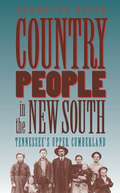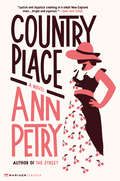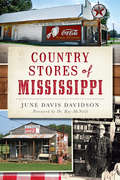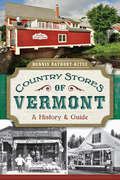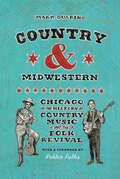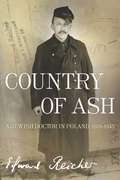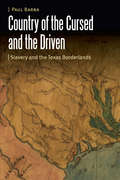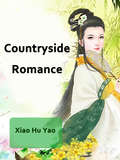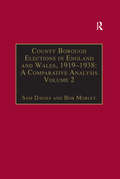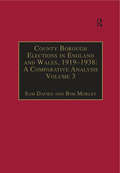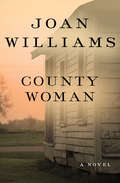- Table View
- List View
Country Never Trod: William Lewis Manly's 1849 Voyage down Utah's Green River
by Michael D. KaneWilliam Lewis Manly was a forty-niner, explorer, and humanitarian whose story most people have never heard.Born in Vermont, William Lewis Manly was drawn out west by the lure of gold. Previous scholarship claims that the Yankee frontiersman floated only 290 miles down the Green River to the Uinta Basin, but author Michael D. Kane&’s research of primary source materials led him to the conclusion that Manly actually traveled 415 miles, all the way to what is now Green River, Utah. This would make Manly the first to explore much of the Green River by boat—twenty years before John Wesley Powell&’s famous expedition.Determined to prove his theory and establish Manly&’s legacy as a trailblazer, Kane conducted research and then built his own wooden canoes and made the trip, tracing Manly&’s footsteps and comparing notes with the earlier traveler. Country Never Trod follows Manly&’s little-known expedition down the Green River and his overland trek through some of the most desolate stretches of Utah, interspersed with Kane&’s journal entries and photographs documenting his own trip.
Country People in the New South
by Jeanette KeithUsing the Tennessee antievolution 'Monkey Law,' authored by a local legislator, as a measure of how conservatives successfully resisted, co-opted, or ignored reform efforts, Jeanette Keith explores conflicts over the meaning and cost of progress in Tennessee's hill country from 1890 to 1925. Until the 1890s, the Upper Cumberland was dominated by small farmers who favored limited government and firm local control of churches and schools. Farm men controlled their families' labor and opposed economic risk taking; farm women married young, had large families, and produced much of the family's sustenance. But the arrival of the railroad in 1890 transformed the local economy. Farmers battled town dwellers for control of community institutions, while Progressives called for cultural, political, and economic modernization. Keith demonstrates how these conflicts affected the region's mobilization for World War I, and she argues that by the 1920s shifting gender roles and employment patterns threatened traditionalists' cultural hegemony. According to Keith, religion played a major role in the adjustment to modernity, and local people united to support the 'Monkey Law' as a way of confirming their traditional religious values.
Country Place: A Novel
by Ann Petry“Petry is the writer we have been waiting for; hers are the stories we need to fully illuminate the questions of our moment, while also offering a page-turning good time. Ann Petry, the woman, had it all, and so does her insightful, prescient and unputdownable prose.” — Tayari Jones, New York Times Book ReviewFrom the author of the bestselling novel The Street, Ann Petry’s classic 1947 novel portrays a small, sleepy New England town grappling with the indignities and lies of American life.Johnnie Roane has come home from four years of fighting in World War II to his loving parents and his beautiful wife, Gloria. But his first doubts of Gloria’s infidelity are created on the way home by the local taxi driver, a passionate gossip, and these doubts which mature with the hurricane that is bearing down on them darkening the seemingly perfect town of Lennox, Connecticut. But a greater violence lurks beneath the surface of the storm…Country Place is a classic, page-turning story that masterfully captures the transformation of small-town life in America from one of the twentieth century’s finest writers.“I’ve recently had my brain re-wired by Ann Petry, and it’s that exhilarating feeling of falling in love with one of your lifetime writers for the first time.” —Brandon Tyler
Country Stores of Mississippi
by June Davis DavidsonThe old country stores along the back roads of rural Mississippi are the treasures that remain of a bygone era. Travel back to the Mississippi of yesteryear and hear of the deadly can of molasses that once caused a massacre in Carrollton, Mississippi, in the late 1800s. Find the church near Alston's General Store in Rodney with a Civil War cannonball lodged in its front facade. Or discover the haunts of Causeyville General Store among shelves and corners stocked with relics of the American past. These and other stores remembered here by local author June Davis Davidson were the cornerstones of their communities, and harken back to a time when the sweetest things in life were the smell of peanuts roasting and reaching into the penny candy jar.
Country Stores of Vermont: A History and Guide (History & Guide)
by Dennis Bathory-KitszVisiting a country store in Vermont is a unique adventure, since each carries its own particular stock of special wares and memorable characters. What all customers should know (and if you forget, any owner will quickly remind you) is that if they don't have it, you don't need it. In Country Stores of Vermont: A History and Guide, author Dennis Bathory-Kitsz takes readers across the state to places that are the very heart of communities big and small, where locals have been keeping their house keys behind the counter and solving the world's problems on the front stoop for over two hundred years.
Country and Midwestern: Chicago in the History of Country Music and the Folk Revival (Emersion: Emergent Village Resources For Communities Of Faith Ser.)
by Mark GuarinoThe untold story of Chicago’s pivotal role as a country and folk music capital. Chicago is revered as a musical breeding ground, having launched major figures like blues legend Muddy Waters, gospel soul icon Mavis Staples, hip-hop firebrand Kanye West, and the jazz-rock band that shares its name with the city. Far less known, however, is the vital role Chicago played in the rise of prewar country music, the folk revival of the 1950s and 1960s, and the contemporary offspring of those scenes. In Country and Midwestern, veteran journalist Mark Guarino tells the epic century-long story of Chicago’s influence on sounds typically associated with regions further south. Drawing on hundreds of interviews and deep archival research, Guarino tells a forgotten story of music, migration, and the ways that rural culture infiltrated urban communities through the radio, the automobile, and the railroad. The Midwest’s biggest city was the place where rural transplants could reinvent themselves and shape their music for the new commercial possibilities the city offered. Years before Nashville emerged as the commercial and spiritual center of country music, major record labels made Chicago their home and recorded legendary figures like Bill Monroe, The Carter Family, and Gene Autry. The National Barn Dance—broadcast from the city’s South Loop starting in 1924—flourished for two decades as the premier country radio show before the Grand Ole Opry. Guarino chronicles the makeshift niche scenes like “Hillbilly Heaven” in Uptown, where thousands of relocated Southerners created their own hardscrabble honky-tonk subculture, as well as the 1960s rise of the Old Town School of Folk Music, which eventually brought national attention to local luminaries like John Prine and Steve Goodman. The story continues through the end of the twentieth century and into the present day, where artists like Jon Langford, The Handsome Family, and Wilco meld contemporary experimentation with country traditions. Featuring a foreword from Grammy-nominated singer-songwriter Robbie Fulks and casting a cross-genre net that stretches from Bob Dylan to punk rock, Country and Midwestern rediscovers a history as sprawling as the Windy City—celebrating the creative spirit that modernized American folk idioms, the colorful characters who took them into new terrain, and the music itself, which is still kicking down doors even today.
Country of Ash
by Elisabeth Bizouard-Reicher Magda Bogin Edward Reicher"[Dr. Reicher] lived through the Second World War in Poland, dodging bullets, uprisings and deportations-not to mention betrayal, starvation and airless hideouts-in a manner more reminiscent of a talented outlaw than a mild-mannered dermatologist . . . It is the impressive simplicity of the good doctor's writing that makes [t]his book resemble [Victor] Klemperer's, and the detailed observations of its report that makes it emotionally memorable. . . . William Carlos Williams once said that people who prize information are perishing daily for want of the information that can be found only in poetry. By the same token, there will never be a time when we will not need the information that an important, evocative book like Country of Ash provides." -VIVIAN GORNICK, Moment magazineCountry of Ash is the starkly compelling, original chronicle of a Jewish doctor who miraculously survived near-certain death, first inside the Lodz and Warsaw ghettoes, where he was forced to treat the Gestapo, then on the Aryan side of Warsaw, where he hid under numerous disguises. He clandestinely recorded the terrible events he witnessed, but his manuscript disappeared during the Warsaw Ghetto Uprising. After the war, reunited with his wife and young daughter, he rewrote his story.Peopled with historical figures like the controversial Chaim Rumkowski, who fancied himself a king of the Jews, to infamous Nazi commanders and dozens of Jews and non-Jews who played cat and mouse with death throughout the war, Reicher's memoir is about a community faced with extinction and the chance decisions and strokes of luck that kept a few stunned souls alive.Edward Reicher (1900-1975) was born in Lodz, Poland. He graduated with a degree in medicine from the University of Warsaw, later studied dermatology in Paris and Vienna, and practiced in Lodz as a dermatologist and venereal disease specialist both before and after World War II. A Jewish survivor of Nazi-occupied Poland, Reicher appeared at a tribunal in Salzburg to identify Hermann Höfle and give an eyewitness account of Höfle's role in Operation Reinhard, which sent hundreds of thousands to their deaths in the Nazi concentration camps of Poland.Country of Ash, first published posthumously in France, was translated from the French by Magda Bogin and includes a foreword by Edward Reicher's daughter Elisabeth Bizouard-Reicher.
Country of My Skull: Guilt, Sorrow, and the Limits of Forgiveness in the New South Africa
by Antjie KrogEver since Nelson Mandela walked out of prison in 1990 after twenty-seven years behind bars, South Africa has been undergoing a radical transformation. In one of the miraculous events of the century, the oppressive system of apartheid was dismantled. What has happened since then?
Country of My Skull: Guilt, Sorrow, and the Limits of Forgiveness in the New South Africa
by Antjie KrogAntjie Krog has worked in acute engagement with the many voices that arose in and around South Africa's Truth and Reconciliation Commission. From the legislative genesis of the Commission, through the testimonies of victims of abuse and violence, and the activities of apartheid's operatives, the appearance of Winnie Madikizela-Mandela, former president PW Botha's courthouse press conference, the Commission's meeting with the media on Robben Island early in 1998 - Antjie Krog leads us on an extraordinary odyssey. COUNTRY OF MY SKULL captures the complexity of the truth commission's work in a uniquely personal narrative which is harrowing, illuminating and provocative. Krog's powerful prose lures the reader actively and inventively through a mosaic of insights, impressions and secret themes. Taking us beneath the big movements of the Truth Commission - and beyond: into the very heart of what is means to be a South African today.
Country of the Bad Wolfes
by James Carlos BlakeA page-turning epic about the making of a borderland crime family, Country of the Bad Wolfes will appeal both to aficionados of family sagas and to fans of hard-knuckled crime novels by the likes of Donald Pollack, Elmore Leonard, James Lee Burke and James Ellroy. Basing the novel partly on his own ancestors, Blake presents the story of the Wolfe family - spanning three generations, centering on two sets of identical twins and the women they love, and ranging from New England to the heart of Mexico before arriving at its powerful climax at the Rio Grande. Begat by an Irish-English pirate in New Hampshire in 1828, the Wolfe family follows its manifest destiny into war-torn Mexico. There, through the connection of a mysterious American named Edward Little, their fortunes intertwine with those of Porfirio Díaz, who will rule the country for more than thirty years before his overthrow by the Revolution of 1910. In the course of those tumultuous chapters in American and Mexican history, as Díaz grows in power, the Wolfes grow rich and forge a violent history of their own, spawning a fearsome legacy that will pursue them to a climactic reckoning at the Río Grande.
Country of the Cursed and the Driven: Slavery and the Texas Borderlands (Borderlands and Transcultural Studies)
by Paul BarbaIn eighteenth- and nineteenth-century Texas—a hotly contested land where states wielded little to no real power—local alliances and controversies, face-to-face relationships, and kin ties structured personal dynamics and cross-communal concerns alike. Country of the Cursed and the Driven brings readers into this world through a sweeping analysis of Hispanic, Comanche, and Anglo-American slaving regimes, illuminating how slaving violence, in its capacity to bolster and shatter families and entire communities, became both the foundation and the scourge, the panacea and the curse, of life in the borderlands. As scholars have begun to assert more forcefully over the past two decades, slavery was much more diverse and widespread in North America than previously recognized, engulfing the lives of Native, European, and African descended people across the continent, from the Atlantic to the Pacific and from Canada to Mexico. Paul Barba details the rise of Texas&’s slaving regimes, spotlighting the ubiquitous, if uneven and evolving, influences of colonialism and anti-Blackness. By weaving together and reframing traditionally disparate historical narratives, Country of the Cursed and the Driven challenges the common assumption that slavery was insignificant to the history of Texas prior to Anglo American colonization, arguing instead that the slavery imported by Stephen F. Austin and his colonial followers in the 1820s found a comfortable home in the slavery-stained borderlands, where for decades Spanish colonists and their Comanche neighbors had already unleashed waves of slaving devastation.
Country on a Precipice: The Precarious State of Human Rights and Civilian Protection in Côte d'Ivoire
by Human Rights WatchThe 35-page report, "Country on a Precipice: The Precarious State of Human Rights and Civilian Protection in Côte d'Ivoire," documents recent military incidents that demonstrate the precariousness of the situation in Côte d'Ivoire. The report also shows how the continued proliferation of militias and the government's practice of using hate speech to incite violence puts civilians at continued risk. The report examines the government offensive against the rebel-held north in November, which was followed by widespread anti-French riots in Abidjan and ethnic clashes in Gagnoa. It also details how the February 28 attack by government-backed militia on the rebel-held town of Logouale sparked ethnically motivated attacks between indigenous groups and immigrant farm workers that resulted in some 16 deaths, caused more than 13,000 villagers to flee, and left several villages in flames. Human Rights Watch found that government forces in the first three months of the year were training and equipping militia forces, including Liberian mercenaries, to renew the war against the rebel New Forces (Forces Nouvelles). The government has been making increasing use of thousands of poorly-trained and ill-disciplined militias that have committed serious crimes with impunity, particularly targeting northerners, Muslims and West African immigrants. The report also notes recent abuses committed by the New Forces rebels against perceived government opponents, including torture and summary execution.
Countrymen
by Bo LidegaardAmid the dark, ghastly history of World War II, the literally extraordinary story, never before fully researched by a historian, of how the Danish people banded together to save their fellow Jews from the Nazis--told through the remarkable unpublished diaries and documents of families forced to run for safety, leaving their homes and possessions behind, and of those who courageously came to their aid. In 1943, with its king and administration weakened but intact during the Nazi occupation, Denmark did something that no other country in Western Europe even attempted. Anticipating that the German occupying powers would soon issue the long-feared order to round up the entire population of Jews for deportation to concentration camps, the Danish people stood up in defiance and resisted. The king, politicians, and ordinary civilians were united in their response--these threatened people were not simply Jews but fellow Danes who happened to be Jewish, and no one would help in rounding them up for confinement and deportation. While diplomats used their limited but very real power to maneuver and impede matters in both Copenhagen and Berlin, the warning that the crisis was at hand quickly spread through the Jewish community. Over fourteen harrowing days, as they were helped, hidden, and protected by ordinary people who spontaneously rushed to save their fellow citizens, an incredible 7,742 out of 8,200 Jewish refugees were smuggled out all along the coast--on ships, schooners, fishing boats, anything that floated--to Sweden. While the bare facts of this exodus have been known for decades, astonishingly no full history of it has been written. Unfolding on a day-to-day basis, Countrymen brings together accounts written by individuals and officials as events happened, offering a comprehensive overview that underlines occupied Denmark's historical importance to Hitler as a prop for the model Nazi state and revealing the savage conflict among top Nazi brass for control of the country. This is a story of ordinary glory, of simple courage and moral fortitude that shines out in the midst of the terrible history of the twentieth century and demonstrates how it was possible for a small and fragile democracy to stand against the Third Reich.
Countryside Romance: Volume 1 (Volume 1 #1)
by Xiao HuyaoSince Mu Yun was attracted by Master Gu and the Mrs. Gu was jealous, she ordered someone to beat up Mu Yun and threw her body into Xiaoshan's ditch. Coincidentally, she was met by the Yuan family who had gone up the mountain, so she brought Mu Yun back home. Mu Yun was very grateful to the Yuan family for saving her, but who would have known that the Yuan family had saved her to marry her daughter, Yan Wu, into a poor mountain ravine? Mu Yun was forced to marry Lin Yan, and on the day of the marriage, she found out that Lin Jinyan was the one who had saved her when she escaped.
Countryside Romance: Volume 2 (Volume 2 #2)
by Xiao HuyaoSince Mu Yun was attracted by Master Gu and the Mrs. Gu was jealous, she ordered someone to beat up Mu Yun and threw her body into Xiaoshan's ditch. Coincidentally, she was met by the Yuan family who had gone up the mountain, so she brought Mu Yun back home. Mu Yun was very grateful to the Yuan family for saving her, but who would have known that the Yuan family had saved her to marry her daughter, Yan Wu, into a poor mountain ravine? Mu Yun was forced to marry Lin Yan, and on the day of the marriage, she found out that Lin Jinyan was the one who had saved her when she escaped.
County Borough Elections in England and Wales, 1919–1938: Volume 1: Barnsley - Bournemouth (County Borough Elections in England and Wales, 1919-1938)
by Sam Davies Bob MorleyThese volumes provide an essential comprehensive work of reference for the annual municipal elections that took place each November in the 83 County Boroughs of England and Wales between 1919 and 1938. They also provide an extensive and detailed analysis of municipal politics in the same period, both in terms of the individual boroughs and of aggregate patterns of political behaviour. Being annual, these local election results give the clearest and most authoritative record of how political opinion changed between general elections, especially useful for research into the longer gaps such as 1924-29 and 1935-45, or crisis periods such as 1929-31. They also illuminate the impact of fringe parties such as the Communist Party and the British Union of Fascists, and also such questions as the role of women in politics, the significance of religious and ethnic differentiation and the connection between occupational and class divisions and party allegiance. Analysis at the ward level is particularly useful for socio-spatial studies. A major work of reference, County Borough Elections in England and Wales, 1919-1938 is indispensable for university libraries and local and national record offices. Each volume has approximately 700 pages.
County Borough Elections in England and Wales, 1919–1938: Volume 2: Bradford - Carlisle (County Borough Elections in England and Wales, 1919-1938)
by Sam Davies Bob MorleyThese volumes provide an essential comprehensive work of reference for the annual municipal elections that took place each November in the 83 County Boroughs of England and Wales between 1919 and 1938. They also provide an extensive and detailed analysis of municipal politics in the same period, both in terms of the individual boroughs and of aggregate patterns of political behaviour. Being annual, these local election results give the clearest and most authoritative record of how political opinion changed between general elections, especially useful for research into the longer gaps such as 1924-29 and 1935-45, or crisis periods such as 1929-31. They also illuminate the impact of fringe parties such as the Communist Party and the British Union of Fascists, and also such questions as the role of women in politics, the significance of religious and ethnic differentiation and the connection between occupational and class divisions and party allegiance. Analysis at the ward level is particularly useful for socio-spatial studies. A major work of reference, County Borough Elections in England and Wales, 1919-1938 is indispensable for university libraries and local and national record offices. Each volume has approximately 700 pages.
County Borough Elections in England and Wales, 1919–1938: Volume 3: Chester to East Ham (County Borough Elections in England and Wales, 1919-1938)
by Sam Davies Bob MorleyThese volumes provide an essential comprehensive work of reference for the annual municipal elections that took place each November in the 83 County Boroughs of England and Wales between 1919 and 1938. They also provide an extensive and detailed analysis of municipal politics in the same period, both in terms of the individual boroughs and of aggregate patterns of political behaviour. Being annual, these local election results give the clearest and most authoritative record of how political opinion changed between general elections, especially useful for research into the longer gaps such as 1924-29 and 1935-45, or crisis periods such as 1929-31. They also illuminate the impact of fringe parties such as the Communist Party and the British Union of Fascists, and also such questions as the role of women in politics, the significance of religious and ethnic differentiation and the connection between occupational and class divisions and party allegiance. Analysis at the ward level is particularly useful for socio-spatial studies. A major work of reference, County Borough Elections in England and Wales, 1919-1938 is indispensable for university libraries and local and national record offices. Each volume has approximately 700 pages.
County Borough Elections in England and Wales, 1919–1938: Volume 4: Exeter - Hull (County Borough Elections in England and Wales, 1919-1938)
by Sam Davies Bob MorleyThese volumes provide an essential comprehensive work of reference for the annual municipal elections that took place each November in the 83 County Boroughs of England and Wales between 1919 and 1938. They also provide an extensive and detailed analysis of municipal politics in the same period, both in terms of the individual boroughs and of aggregate patterns of political behaviour. Being annual, these local election results give the clearest and most authoritative record of how political opinion changed between general elections, especially useful for research into the longer gaps such as 1924-29 and 1935-45, or crisis periods such as 1929-31. They also illuminate the impact of fringe parties such as the Communist Party and the British Union of Fascists, and also such questions as the role of women in politics, the significance of religious and ethnic differentiation and the connection between occupational and class divisions and party allegiance. Analysis at the ward level is particularly useful for socio-spatial studies. A major work of reference, County Borough Elections in England and Wales, 1919-1938 is indispensable for university libraries and local and national record offices. Each volume has approximately 700 pages.
County Class Cruisers
by Les Brown&“A detailed look at British 10,000-ton Treaty Cruisers. &“A gem of research by the author, covering the design and progressive improvements to each ship.&”—Malcolm Wright, author of British and Commonwealth Warship Camouflage of WWII The ShipCraft series provides in-depth information about building and modifying model kits of famous warship types. Lavishly illustrated, each book takes the modeler through a brief history of the subject class, highlighting differences between sisterships and changes in their appearance over their careers. This includes paint schemes and camouflage, featuring color profiles and highly detailed line drawings and scale plans. The modeling section reviews the strengths and weaknesses of available kits, lists commercial accessory sets for super-detailing of the ships, and provides hints on modifying and improving the basic kit. This is followed by an extensive photographic gallery of selected high-quality models in a variety of scales, and the book concludes with a section on research references books, monographs, large-scale plans and relevant websites. This volume covers the British 10,000-ton Treaty Cruisers, thirteen of which were built to three slightly varying designs between the wars. With three funnels and a high freeboard, they were impressive ships, and all enjoyed very active wartime careers—three were involved in the Bismarck action and another with the sinking of the Scharnhorst. &“This book by Les Brown is rather like the Sci-Fi &‘Tardis&’ in that its outside belies the tremendous amount on the inside.&”—Malcolm Wright, author of British and Commonwealth Warship Camouflage of WWII
County Durham Folk Tales
by Adam Bushnell Nigel CliftonStoryteller and author Adam Bushnell brings together stories from the rugged coastlines, limestone cliffs, remote moorland, pastoral dales and settled coalfields of County Durham. In this treasure trove of tales you will meet the evil fairies of Weardale, the shape-changing witch from Easington, the Bishop Auckland boar, the Dun Cow from Durham City and many other characters – all as fantastical and powerful as the landscape they inhabit. Retold in an engaging style, and richly illustrated with unique line drawings, these humorous, clever and enchanting folk tales are sure to be enjoyed and shared time and again.
County Fair
by Laura Ingalls Wilder Jody WheelerIt's an exciting day for Almanzo as the Wilder family visits the county fair in this second My First Little House Book adapted from Laura Ingalls Wilder's classic Farmer Boy. There are contests, races, and good things to eat, and Almanzo can't wait to see what the judges think of his special pumpkin. Jody Wheeler's luminous illustrations bring Laura's beloved farmer boy to life.
County Woman: A Novel
by Joan WilliamsA precisely observed portrait of the civil rights era and the gripping story of one woman&’s unexpected awakening Itna Homa, Mississippi, is like many small Southern towns in the early 1960s. News travels fast, gossip even faster, and one ugly incident has the power to set the entire community aflame. Forty years ago, the murder of a local white woman shook Itna Homa to its core and resulted in the conviction—based on circumstantial evidence—of a young black man. Now desegregation at the University of Mississippi is the talk of the town, and fear and prejudice once again threaten to tear friends and families apart. For middle-aged housewife Allie McCall, the civil rights movement offers a welcome opportunity to reconsider her own life. She is open to the new ideas about race, class, and gender that are sweeping the country, and eager to see them gain greater acceptance in her hometown. Shocking her husband, Tate, and confounding the local political establishment, Allie enters the race for town constable against a long-serving and bigoted incumbent. As a voice for progressive reform, Allie hopes to encourage her like-minded neighbors to speak up. But her quest has another, more personal component—it was Allie&’s mother who was killed all those years ago, and Elgie Hale, the man accused of the crime, has recently escaped from prison. Allie will risk everything—her marriage, her safety, her principles—to track down Hale and determine his guilt or innocence once and for all.
County: Life, Death and Politics at Chicago's Public Hospital
by David A. AnsellThe amazing tale of “County” is the story of one of America’s oldest and most unusual urban hospitals. From its inception as a “poor house” dispensing free medical care to indigents, Chicago’s Cook County Hospital has been renowned as a teaching hospital and the healthcare provider of last resort for the city’s uninsured. Ansell covers more than thirty years of its history, beginning in the late 1970s when the author began his internship, to the “Final Rounds” when the enormous iconic Victorian hospital building was replaced. Ansell writes of the hundreds of doctors who underwent rigorous training with him. He writes of politics, from contentious union strikes to battles against “patient dumping,” and public health, depicting the AIDS crisis and the Out of Printening of County’s HIV/AIDS clinic, the first in the city. And finally it is a coming-of-age story for a young doctor set against a backdrOut of Print of race, segregation, and poverty. This is a riveting account.
County: Life, Death, and Politics at Chicago's Public Hospital
by David Ansell"County" is the amazing tale of one of America's oldest and most unusual urban public hospitals. From its inception as a "poor house" dispensing free medical care to indigents, Chicago's Cook County Hospital has been both a renowned teaching hospital and the health care provider of last resort for the city's uninsured. "County" covers more than thirty years of its history, beginning in the late 1970s when the author began his internship, to the "final rounds" in 2002, when hundreds of former trainees and personnel, many of whom shared Ansell's vision of resurrecting a hospital in critical condition, gathered to bid the iconic Victorian hospital building an emotional farewell before it was closed to make way for a new facility."County" is about people--from Ansell's mentors, including the legendary Quentin Young, to the multitude of patients whom he and County's medical staff labored to diagnose and heal. It is a story about politics; from contentious union strikes, to battles against "patient dumping." Most importantly, it chronicles the battles for instigating new programs that would help to prevent, rather than just treat, serious illnesses, including the opening of County's HIV/AIDS clinic (the first in the city), as well as an early-detection breast cancer screening program. Finally, it is about an idealistic young man's medical education in urban America, a coming-of-age story set against a backdrop of race, segregation, and poverty.

